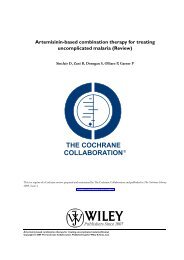Antiamoebic drugs for treating amoebic colitis - The Cochrane Library
Antiamoebic drugs for treating amoebic colitis - The Cochrane Library
Antiamoebic drugs for treating amoebic colitis - The Cochrane Library
You also want an ePaper? Increase the reach of your titles
YUMPU automatically turns print PDFs into web optimized ePapers that Google loves.
Batra 1972 (Continued)<br />
Not included in this review: number of hours from start of treatment to reduction in diarrhoea, tenesmus, and bloody<br />
stools; disappearance of colonic ulcers on sigmoidoscopic examination on day 5 and day 11 of treatment<br />
Notes Location: hospital in New Delhi, India<br />
Date: 1972 (date of publication only; actual study period not reported)<br />
Source of funding: Merck, Sharp and Dohme<br />
Botero 1974<br />
Methods Generation of allocation sequence: unclear<br />
Allocation concealment: unclear<br />
Blinding: unclear; reported as “double-blind”, but blinding of participants, care provider, and outcome assessors not<br />
described<br />
Inclusion of all randomized participants: 95.8% (115/120)<br />
Participants Number: 120 enrolled; 115 analysed; 5 lost to follow up; 1 participant in the Ro 7-0207 terminated treatment after<br />
day 6 because of adverse effects<br />
Inclusion criteria: adult males with clinical symptoms of intestinal amoebiasis and confirmed by the presence of E.<br />
histolytica in the stools examined by direct and Ritchie <strong>for</strong>malin-ether concentration methods<br />
Exclusion criteria: not stated<br />
Interventions 1. Ro 7-0207 (ornidazole): 2 x 250 mg capsules twice daily <strong>for</strong> 10 days<br />
2. Metronidazole: 2 x 250 mg capsules twice daily <strong>for</strong> 10 days<br />
Outcomes 1. Parasitological response: clearance of E. histolytica from stools at the end of treatment and on at weekly<br />
intervals on follow up <strong>for</strong> at least 1 month<br />
2. Relapse: reappearance of E. histolytica in the stools within 1 month after becoming negative at the end of<br />
treatment<br />
3. Clinical response: disappearance or improvement of clinical signs and symptoms on day 5, at the end of<br />
treatment, and at weekly intervals during follow up <strong>for</strong> at least 1 month<br />
4. Adverse events: clinical adverse events monitored <strong>for</strong> all participants but cardiovascular, neurological, and<br />
laboratory monitoring only <strong>for</strong> the first 20 participants (laboratory tests not specified)<br />
Notes Location: hospital in Medellin, Colombia<br />
Date: 1974 (date of publication only; actual study period not reported)<br />
Source of funding: not stated<br />
Botero 1977<br />
Methods Generation of allocation sequence: unclear<br />
Allocation concealment: unclear<br />
Blinding: unclear; reported as “double-blind”, but blinding of participants, care provider, and outcome assessors not<br />
described<br />
Inclusion of all randomized participants: 100%<br />
Participants Number: 100 enrolled and 100 analysed<br />
Inclusion criteria: adult males with clinical symptoms of intestinal amoebiasis and stools positive <strong>for</strong> E. histolytica<br />
examined by direct and Ritchie <strong>for</strong>malin-ether concentration methods<br />
<strong>Anti<strong>amoebic</strong></strong> <strong>drugs</strong> <strong>for</strong> <strong>treating</strong> <strong>amoebic</strong> <strong>colitis</strong> (Review)<br />
Copyright © 2009 <strong>The</strong> <strong>Cochrane</strong> Collaboration. Published by John Wiley & Sons, Ltd.<br />
35








